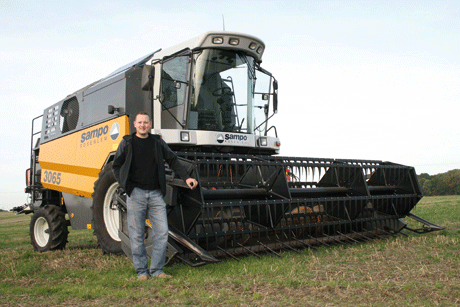Sampo Rosenlew makes a bid for the smaller UK combine market

While most manufacturers are battling to produce ever-larger combines, one company is making the most of its experience of the smaller end of the market. Finnish company Sampo Rosenlew, better known for its plot combines, is entering the UK market with a low-cost option for smaller farmers.
As first harvests go, this one has been exceptionally tough on any new combine, let alone one that has just made its debut in the UK market. But Roy and Ashley Greenhall say their Sampo Rosenlew 3065 has coped admirably.
The father-and-son team cut almost 170ha (400 acres) of crops, mainly wheat and beans, on their farm near Sawbridgeworth, Hertfordshire.
Their choice to go with a manufacturer new to the UK market was a brave one. It was driven by what they see as the over-complication and high price of many combines on the market, but also their trust in Sampo’s UK outlet, Trials Equipment, and its boss, Colin Coleman.
“The largest of these combines will deal with about 1200 acres, so they are very much aimed at the smaller farmer who still wants to own a combine,” says Mr Coleman.
The 3065, complete with 5.2m header, replaces a Deutz 3610 MTS 180hp machine with an 18ft header. Maintenance is pretty straightforward, says son Ashley Greenhall, who drives the combine most of the time. “Daily, it’s just a matter of checking belt tensions, greasing three nipples and checking the oiling point on the reel,” he says. “Every 50 hours, or five days, it takes about half an hour to grease 10 further points and carry out the usual checks.”

Optional extras, such as an upgraded grain-monitoring system, a reversing camera and electronic chopper and chaff spreader, have been added to tailor the combine more to the Greenhalls’ needs. “The rear-view monitor is handy for controlling the electric straw chopper to avoid spreading chopped straw on standing crop,” adds Ashley.
Powered by a Sisu diesel engines, the Greenhalls’ combine has a power upgrade from 210hp to 250hp – and this year it has coped well, even with wet straw. “After running an older machine, the engine is extremely quiet, even at high revs,” says Ashley. “We also went for a self-levelling header, which gave us added confidence when running on undulating land.”
Because of Sampo’s experience of the seed industry, things are relatively clear-cut inside, too. Straw walkers can be pulled out in one go, the preparation tray can be opened up easily, and the two feed augers in the grain tank can be unclipped and pulled out so the tank to be swept out quickly.
“It’s given a clean sample in wet conditions,” adds Roy. “And because there’s a straight run-up the unloading auger, there is a lot less strain and you don’t even notice a dip in power when unloading. With the wet grain we were dealing with, this was the year to show it up.”
A three-speed hydrostatic transmission is standard on all models, and there is an option for a mechanical transmission on the smaller 2000 series machines at lower cost.
“We’re looking forward to seeing it in a normal year, because it’s performed well so far,” adds Roy Greenhall.

